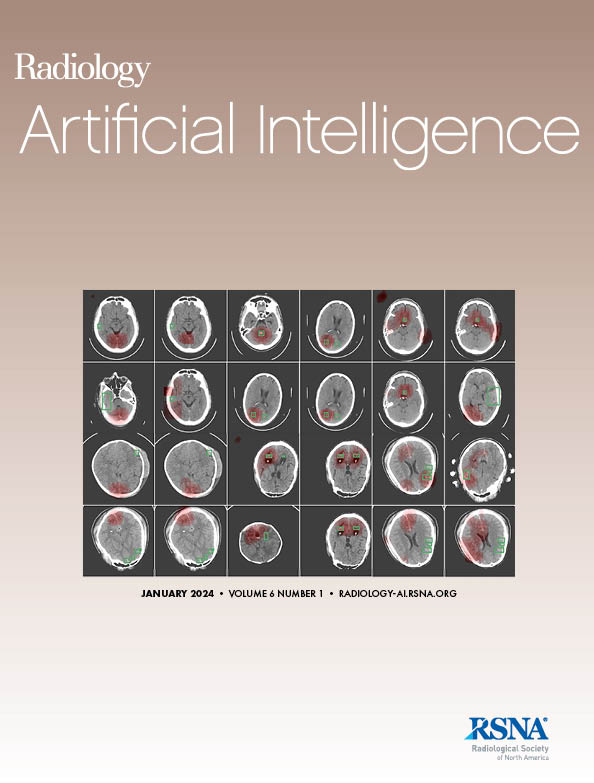William Lotter, Daniel S Hippe, Thomas Oshiro, Kathryn P Lowry, Hannah S Milch, Diana L Miglioretti, Joann G Elmore, Christoph I Lee, William Hsu
求助PDF
{"title":"乳房x线摄影采集参数对人工智能和放射科医生解释性能的影响。","authors":"William Lotter, Daniel S Hippe, Thomas Oshiro, Kathryn P Lowry, Hannah S Milch, Diana L Miglioretti, Joann G Elmore, Christoph I Lee, William Hsu","doi":"10.1148/ryai.240861","DOIUrl":null,"url":null,"abstract":"<p><p>Purpose To evaluate the impact of screening mammography acquisition parameters on the interpretive performance of AI and radiologists. Materials and Methods The associations between seven mammogram acquisition parameters-mammography machine version, kVp, x-ray exposure delivered, relative x-ray exposure, paddle size, compression force, and breast thickness-and AI and radiologist performance in interpreting two-dimensional screening mammograms acquired by a diverse health system between December 2010 and 2019 were retrospectively evaluated. The top 11 AI models and the ensemble model from the Digital Mammography DREAM Challenge were assessed. The associations between each acquisition parameter and the sensitivity and specificity of the AI models and the radiologists' interpretations were separately evaluated using generalized estimating equations-based models at the examination level, adjusted for several clinical factors. Results The dataset included 28,278 screening two-dimensional mammograms from 22,626 women (mean age 58.5 years ± 11.5 [SD]; 4913 women had multiple mammograms). Of these, 324 examinations resulted in breast cancer diagnosis within 1 year. The acquisition parameters were significantly associated with the performance of both AI and radiologists, with absolute effect sizes reaching 10% for sensitivity and 5% for specificity; however, the associations differed between AI and radiologists for several parameters. Increased exposure delivered reduced the specificity for the ensemble AI (-4.5% per 1 SD increase; <i>P</i> < .001) but not radiologists (<i>P</i> = .44). Increased compression force reduced the specificity for radiologists (-1.3% per 1 SD increase; <i>P</i> < .001) but not for AI (<i>P</i> = .60). Conclusion Screening mammography acquisition parameters impacted the performance of both AI and radiologists, with some parameters impacting performance differently. ©RSNA, 2025.</p>","PeriodicalId":29787,"journal":{"name":"Radiology-Artificial Intelligence","volume":" ","pages":"e240861"},"PeriodicalIF":13.2000,"publicationDate":"2025-09-17","publicationTypes":"Journal Article","fieldsOfStudy":null,"isOpenAccess":false,"openAccessPdf":"","citationCount":"0","resultStr":"{\"title\":\"Influence of Mammography Acquisition Parameters on AI and Radiologist Interpretive Performance.\",\"authors\":\"William Lotter, Daniel S Hippe, Thomas Oshiro, Kathryn P Lowry, Hannah S Milch, Diana L Miglioretti, Joann G Elmore, Christoph I Lee, William Hsu\",\"doi\":\"10.1148/ryai.240861\",\"DOIUrl\":null,\"url\":null,\"abstract\":\"<p><p>Purpose To evaluate the impact of screening mammography acquisition parameters on the interpretive performance of AI and radiologists. Materials and Methods The associations between seven mammogram acquisition parameters-mammography machine version, kVp, x-ray exposure delivered, relative x-ray exposure, paddle size, compression force, and breast thickness-and AI and radiologist performance in interpreting two-dimensional screening mammograms acquired by a diverse health system between December 2010 and 2019 were retrospectively evaluated. The top 11 AI models and the ensemble model from the Digital Mammography DREAM Challenge were assessed. The associations between each acquisition parameter and the sensitivity and specificity of the AI models and the radiologists' interpretations were separately evaluated using generalized estimating equations-based models at the examination level, adjusted for several clinical factors. Results The dataset included 28,278 screening two-dimensional mammograms from 22,626 women (mean age 58.5 years ± 11.5 [SD]; 4913 women had multiple mammograms). Of these, 324 examinations resulted in breast cancer diagnosis within 1 year. The acquisition parameters were significantly associated with the performance of both AI and radiologists, with absolute effect sizes reaching 10% for sensitivity and 5% for specificity; however, the associations differed between AI and radiologists for several parameters. Increased exposure delivered reduced the specificity for the ensemble AI (-4.5% per 1 SD increase; <i>P</i> < .001) but not radiologists (<i>P</i> = .44). Increased compression force reduced the specificity for radiologists (-1.3% per 1 SD increase; <i>P</i> < .001) but not for AI (<i>P</i> = .60). Conclusion Screening mammography acquisition parameters impacted the performance of both AI and radiologists, with some parameters impacting performance differently. ©RSNA, 2025.</p>\",\"PeriodicalId\":29787,\"journal\":{\"name\":\"Radiology-Artificial Intelligence\",\"volume\":\" \",\"pages\":\"e240861\"},\"PeriodicalIF\":13.2000,\"publicationDate\":\"2025-09-17\",\"publicationTypes\":\"Journal Article\",\"fieldsOfStudy\":null,\"isOpenAccess\":false,\"openAccessPdf\":\"\",\"citationCount\":\"0\",\"resultStr\":null,\"platform\":\"Semanticscholar\",\"paperid\":null,\"PeriodicalName\":\"Radiology-Artificial Intelligence\",\"FirstCategoryId\":\"1085\",\"ListUrlMain\":\"https://doi.org/10.1148/ryai.240861\",\"RegionNum\":0,\"RegionCategory\":null,\"ArticlePicture\":[],\"TitleCN\":null,\"AbstractTextCN\":null,\"PMCID\":null,\"EPubDate\":\"\",\"PubModel\":\"\",\"JCR\":\"Q1\",\"JCRName\":\"COMPUTER SCIENCE, ARTIFICIAL INTELLIGENCE\",\"Score\":null,\"Total\":0}","platform":"Semanticscholar","paperid":null,"PeriodicalName":"Radiology-Artificial Intelligence","FirstCategoryId":"1085","ListUrlMain":"https://doi.org/10.1148/ryai.240861","RegionNum":0,"RegionCategory":null,"ArticlePicture":[],"TitleCN":null,"AbstractTextCN":null,"PMCID":null,"EPubDate":"","PubModel":"","JCR":"Q1","JCRName":"COMPUTER SCIENCE, ARTIFICIAL INTELLIGENCE","Score":null,"Total":0}
引用次数: 0
引用
批量引用

 求助内容:
求助内容: 应助结果提醒方式:
应助结果提醒方式:


